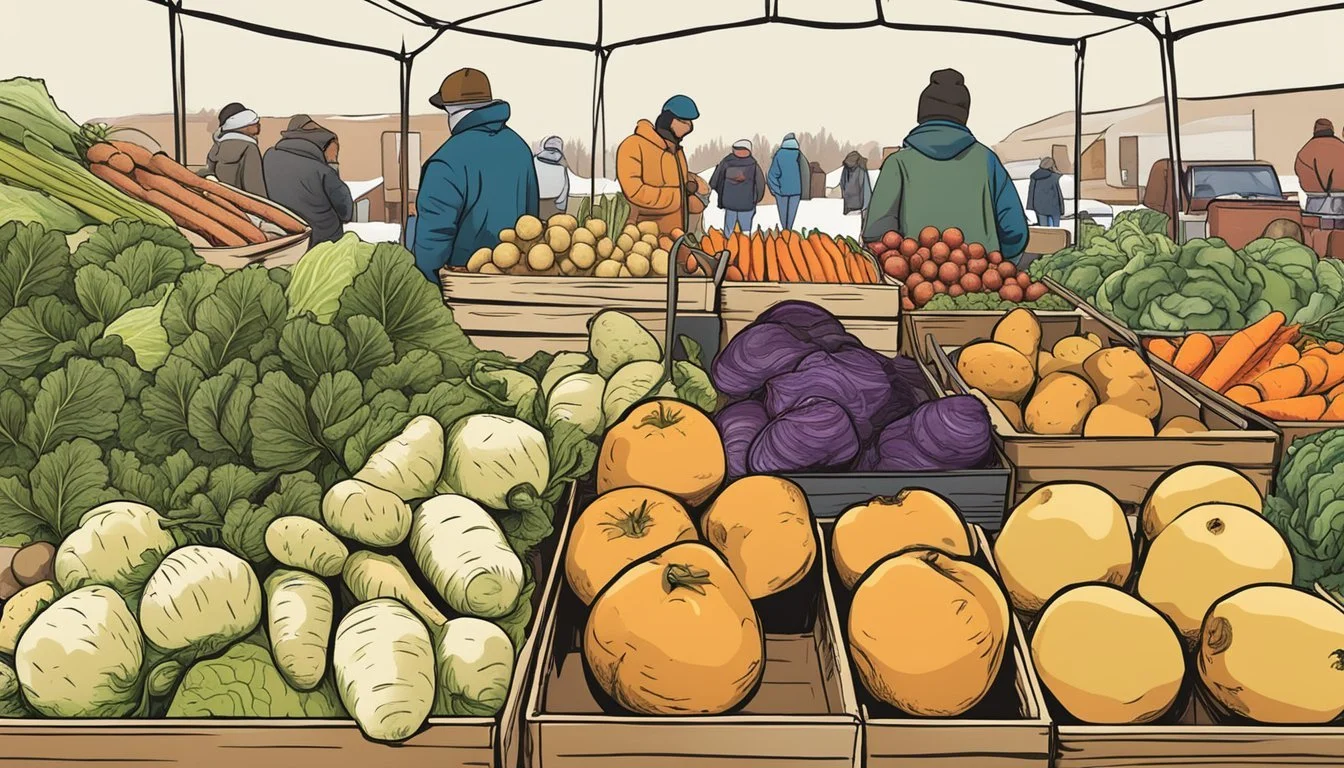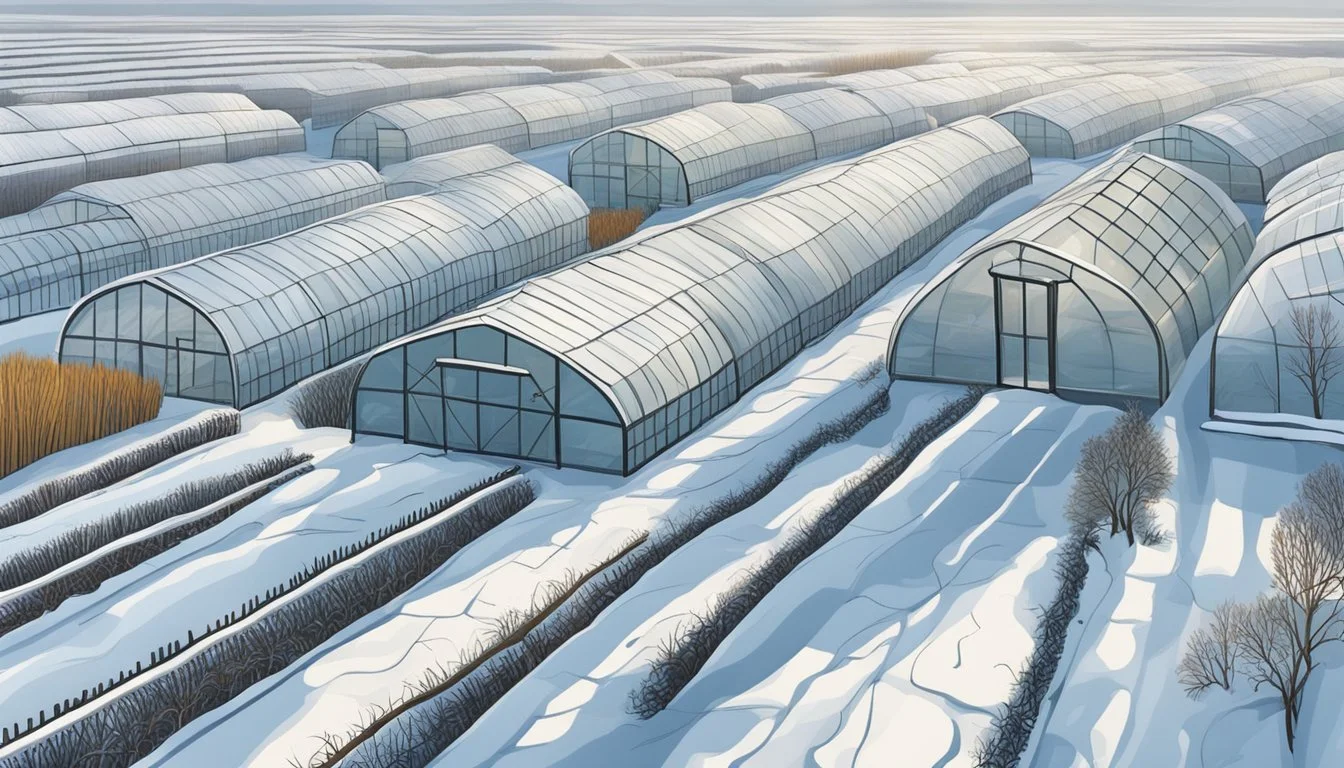North Dakota Seasonal Fruit & Vegetables in February
A Guide to Winter Produce Selection
This Article is Part of our North Dakota Seasonal Fruit & Veg Calendar
As winter maintains its grip on North Dakota in February, residents and visitors have an opportunity to explore the region's offerings of fresh produce despite the colder climate. Even in these brisk months, North Dakota provides a surprising variety of fruits (What wine goes well with fruits?) and vegetables that are in their prime. The state's seasonal produce calendar indicates that while selections may be more limited compared to the bountiful summer months, there are still plenty of fresh options available.
Citrus fruits, for example, are a highlight of the season and are at their peak of freshness during this time. Shoppers can look forward to vibrant lemons, limes, and oranges, offering a burst of flavor and nutrition. These citrus options are not only perfect for a winter vitamin C boost but also add a welcome splash of color to the season's palette. Root vegetables and hearty greens are also commonly available and can be used in an array of warming dishes perfect for February's cooler temperatures.
Supporting local farmers by purchasing in-season produce during this month not only provides the freshest fruits and veggies but also sustains the local economy during the off-peak season. North Dakotans take pride in the resilience and productivity of their agricultural sector, ensuring that the community benefits from a seasonal eating guide tailored to the local environment.
Overview of North Dakota Seasonal Produce
In North Dakota, February is a winter month with limited fresh produce due to its cold climate and hardiness zone considerations. However, understanding these constraints is essential for those interested in the state's seasonality and available harvest.
Importance of Seasonality
Seasonal produce is crucial for various reasons, including freshness, nutritional value, and support for local agriculture. In North Dakota, seasonality affects not only the variety but also the quality of available produce. Consumers and farmers alike navigate these cycles to maximize the benefits of their regional bounty.
Understanding the North Dakota Climate
North Dakota's climate is characterized by cold, snowy winters and short, warm summers. It's situated predominantly in USDA Hardiness Zones 3 and 4, which greatly influence the growing season. Winters are generally harsh, with February being one of the coldest months, impacting what types of produce can survive and thrive during this period.
February's Agricultural Context
During February, North Dakota sees very little in the way of fresh, outdoor-harvested produce due to winter conditions. Hearty winter storage crops and greenhouse-grown items are typically what's available. Most outdoor farming is at a standstill until temperatures rise, and the snow thaws, setting the stage for spring planting.
Seasonal Fruits in February
February in North Dakota offers a refreshing variety of fruits despite the chilly weather. Consumers can take advantage of the hearty flavors and nutritional benefits these seasonal selections provide.
Available Fruits
Citrus: February is a prominent month for citrus fruits, offering a burst of vibrant flavors.
Lemons
Limes
Oranges
Pome Fruits: These fruits remain good choices for the season.
Apples
Pears
Each fruit has its own unique flavor profile, ranging from the tartness of citrus to the sweet, mellow taste of apples and pears.
Health Benefits of Seasonal Fruits
Seasonal fruits such as citrus and apples are not only flavorful but are also packed with vitamins and antioxidants. Consuming these fruits can boost the immune system, which is especially beneficial during the cold season. Citrus fruits are rich in vitamin C, vital for immune function, while apples provide dietary fiber for digestive health.
Fruit Preservation Techniques
To extend the enjoyment of seasonal fruits beyond their natural availability, several preservation methods can be utilized:
Canning: Suitable for making preserves and jams, retaining the fruit's flavor and extending its shelf life for months.
Freezing: Ideal for maintaining the nutritional value of fruits; it's a practical option for citrus sections and peeled, cored apples and pears.
Jam-Making: A popular method to capture the essence of fruits, especially for apples, into a spreadable form that pairs well with various foods.
By employing these preservation techniques, one can enjoy the flavors of February's fruits throughout the year.
Seasonal Vegetables in February
In February, the cold North Dakota climate offers a selection of vegetables that thrive during this time, bringing a mix of flavors and health benefits.
Available Vegetables
Root Vegetables:
Beets (how long do beets last?)
Carrots
Potatoes
Celery root (Celeriac)
Cruciferous Vegetables:
Brussels sprouts
Cabbage
Cauliflower
Broccoli
Leafy Greens:
Kale
Lettuce
Others:
Winter squash
Health Benefits of Seasonal Vegetables
Root vegetables, like beets and parsnips, are high in fiber and essential vitamins. Cruciferous vegetables such as cabbage, brussels sprouts, and broccoli contain compounds that research suggests may help prevent certain diseases. The leafy greens, particularly kale, are recognized for their nutrient density and antioxidant properties.
Vegetable Storage and Preparation
Root Vegetables: Store in a cool, dark place. Ideal for roasting to enhance their natural sweetness.
Cruciferous Vegetables: Refrigerate in airtight containers. Perfect for steaming or stir-frying.
Leafy Greens: Keep in the crisper section of the refrigerator; use them fresh in salads or sautéed.
Winter Squash: Store in a cool, well-ventilated area and use in a variety of dishes from soups to baked goods.
When it comes to preparation, many North Dakota vegetables can be preserved. Canning is popular for items like beets and cabbage, which can be turned into pickles or salsa. Flavor is paramount, and these seasonal offerings provide a plethora of options for enhancing dishes.
North Dakota's Farming Calendar
North Dakota exhibits a definite rhythm in its farming calendar, with specific times for planting and harvesting throughout the year. Knowing these periods is crucial for farmers and consumers alike to ensure optimal produce quality and availability.
Annual Crops Timeline
Spring (March to May): Farmers start sowing early-season crops as the ground thaws.
Summer (June to August): The bulk of planting is done by June, with some late-season crops sown in July.
Fall (September to November): Harvesting begins, peaking in September and October.
Winter (December to February): Limited field activities; some winter-hardy crops are still harvested.
Optimal Harvest Periods
Month Crops Ready for Harvest June Light vegetables and some berries July Berries, full range of vegetables August Corn, root vegetables September - October Squashes, pumpkins, late-season fruits November Last of the root crops before deep frost
During February, the focus shifts from harvest to preparation for the upcoming sowing season, as the ground remains predominantly frozen.
Off-Season Farming Activities
Winter (December to February): Farmers engage in planning for the next growing cycle, machinery maintenance, and attending agricultural conferences.
Early Spring (March): Greenhouse planting begins, and preparations for fieldwork ramp up as the snow melts.
This period is critical in North Dakota for strategic planning and ensuring machinery and supplies are ready for the intense planting and growing months ahead.
Agricultural Practices in North Dakota
In North Dakota, agricultural practices are tailored to the state's unique climate and soil conditions, with a focus on sustainability, disease management, and data-driven decisions.
Sustainable Farming Techniques
North Dakota has adopted various sustainable farming techniques to maintain the productivity of its land. These include crop rotation, which helps prevent soil depletion, and cover cropping to protect and enrich the soil during off-season periods. Farmers in the state are conscious of the hardiness zones, which dictate the types of crops that can be grown in specific areas, allowing them to plan for sustainable crop production.
Disease Management and Prevention
Disease management is a critical aspect of North Dakota's agriculture. Farmers employ integrated pest management (IPM) strategies to control crop diseases. This involves regular monitoring of pest levels, utilizing disease-resistant crop varieties, and applying fungicides judiciously to mitigate disease spread. The state invests in research to understand plant pathogens prevalent in its hardiness zones, enabling preventative measures tailored to local conditions.
Research and Data Analysis
Data analysis and research are integral to refining agricultural practices in North Dakota. The state's agricultural sector utilizes data from experimental farms and university-led studies to optimize crop yields and improve crop varieties' resilience to the local climate. This research is especially important for formulating strategies for long-term sustainability within the state's designated hardiness zones, ensuring that the agriculture sector can adapt to changing environmental conditions and market demands.
Local Markets and Farms
In North Dakota, February marks a period when local markets and farms play a vital role in providing fresh, seasonal produce despite the challenges posed by the cold climate.
Finding Local Produce
In February, North Dakota's farmers markets and local farms may offer winter-hardy items and stored crops such as root vegetables. The Grand Forks Town Square Farmer's Market, although more active in warmer months, can still provide access to local goods through indoor events or pick-up options. Residents seeking fresh, local produce can check with specific markets for winter availability.
Community Supported Agriculture
Community Supported Agriculture (CSA) programs are pivotal in supporting local farms during the off-peak growing season. They allow residents to purchase a share of anticipated harvests, providing them with periodic distributions of fresh produce. Farms like Heart and Soil Farm in Grandin, ND, utilize organic practices, contributing to the community with sustainably grown fruits and vegetables.
Economic Impact of Local Farming
The economy of local communities in North Dakota benefits substantially from farmers markets and local farming operations. These markets foster economic activity within the state and enable consumers to support local agriculture directly. By doing so, communities ensure the sustainability of rural North Dakota and maintain a network of fresh, locally-grown products that bolster the region's food security.
Preparing and Enjoying Seasonal Produce
In February, individuals in North Dakota can utilize the limited seasonal produce available through various cooking methods and by understanding the nutritional benefits. They can also enrich their habits with educational resources focused on healthy eating.
Recipes and Cooking Tips
Canning: Preserve the flavors of root vegetables through canning. Pickling beets enhances their natural sweetness and provides a tangy flavor that can be enjoyed year-round.
Freezing: For vegetables such as carrots, blanching and freezing is a practical option to retain nutrients and ensure a supply of fresh-tasting produce.
Jam: While fruit selections may be sparse, making jam from stored autumn berries can provide a flavorful spread for many meals.
Salsa: Utilize stored or canned tomatoes (how long does canned tomatoes last?) to create a zesty salsa, which can bring a refreshing twist to dishes.
Nutritional Guidelines
Root Vegetables: They are typically rich in vitamins A and C, essential for immunity and eye health.
Preserved Fruits: Even when consumed out of season, they offer beneficial fiber and vitamins.
Balance: Include a diverse range of seasonal produce to maximize nutritional intake.
Educational Resources for Healthy Eating
Health Education: Seek local cooking classes that include lessons on preparing and storing seasonal produce.
Online Tutorials: They offer step-by-step guidance on methods such as canning and making jams, increasing one's self-reliance for year-round enjoyment of seasonal flavors.









